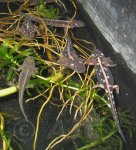nate
Member
- Joined
- Feb 6, 2001
- Messages
- 846
- Reaction score
- 4
- Points
- 18
- Location
- Wichita, KS
- Country
- United States
- Display Name
- Nate
Well, it's been a couple months since I've been working with some imported WC N. kaiseri here at my zoo. I had always read and been told by the vast majority of people who had kept/were keeping kaiseri that they were very shy, terrified of light, and poor captives. Just thought I'd go through these assertions with what I've seen of them.
Shy
Being WC, they were fairly shy at first and most were tentative eaters. This has changed markedly. Although they do seem to prefer to be in a cave, facing outward, they regularly wander about in the open and some do not hesitate now to rush the glass and follow me, hoping for food. They regulalry beg and when food hits the water now, they begin to scurry all around the tank to find it. Overall, I'd say that they are no more shy than any other freshly caught newt I've experienced and within a couple months, have become just as tame as any other newt
Light Sensitive
Generally when I first check on them early in the morning, they are out in the open. After the lights come on, they gradually work their way back to a favorite cave...or not. They definitely do not seem to be afraid of the light nor shocked by it now. I should also mention that even though they prefer a cave, their heads are often sticking out into the light as they watch for any passing motion much like a Pachytriton or Calotriton. They were also courting in full light. Overall, I'd say they are no more light-sensitive than any other newt I've worked with.
Poor Captives
Well, see above. They eat well and are active. They certainly did not arrive in the best of health and there have been losses, but that can be said of any imported newts. We've also got eggs/larvae and so I look forward to the experience!
Shy
Being WC, they were fairly shy at first and most were tentative eaters. This has changed markedly. Although they do seem to prefer to be in a cave, facing outward, they regularly wander about in the open and some do not hesitate now to rush the glass and follow me, hoping for food. They regulalry beg and when food hits the water now, they begin to scurry all around the tank to find it. Overall, I'd say that they are no more shy than any other freshly caught newt I've experienced and within a couple months, have become just as tame as any other newt
Light Sensitive
Generally when I first check on them early in the morning, they are out in the open. After the lights come on, they gradually work their way back to a favorite cave...or not. They definitely do not seem to be afraid of the light nor shocked by it now. I should also mention that even though they prefer a cave, their heads are often sticking out into the light as they watch for any passing motion much like a Pachytriton or Calotriton. They were also courting in full light. Overall, I'd say they are no more light-sensitive than any other newt I've worked with.
Poor Captives
Well, see above. They eat well and are active. They certainly did not arrive in the best of health and there have been losses, but that can be said of any imported newts. We've also got eggs/larvae and so I look forward to the experience!

